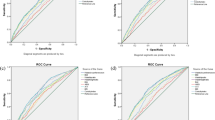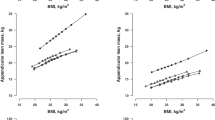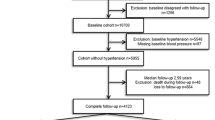Abstract
Objective: Waist circumference (WC) cut-points of ⩾102 cm and ⩾88 cm for men and women, respectively, representing abdominal obesity have been recommended for determining obesity related co-morbidities. However, these cut-points carry the component of generalised obesity estimated by body mass index (BMI). The aim of this investigation was to determine whether abdominal obesity free of the influence of overall heaviness is associated with increased risk of hypertension in a representative sample of white and black Americans.
Methods: Data (n = 11114) from the Third US National Health and Nutrition Examination Survey were used in this investigation. Standardised residual values from the linear regression of WC on BMI were used to define abdominal obesity status. The risk of hypertension associated with abdominal obesity was estimated from the logistic regression model, adjusting for age, smoking and alcohol. We also estimated the public health consequences of abdominal obesity from the population attributable fraction of hypertension.
Results: Relative to white, black race/ethnicity was associated with ∼1.8 and ∼2.7 greater risk of hypertension in men and women, respectively, adjusting for abdominal obesity, age, smoking and alcohol consumption. Having larger than expected waist girths were associated with 1.58 and 1.39 increased risk of hypertension in black men and black women, respectively, adjusting for confounders. Population attributable risks of hypertension due to abdominal obesity were approximately 24.9% and 15.9%, in black men and black women, respectively.
Conclusions: In Americans, hypertension is a public health problem that is closely linked to abdominal adiposity. An important research challenge therefore is to determine the best way to regulate body weight under conditions of food abundance. There is a need to clarify how lifestyle habits promote large waist sizes leading to abdominal adiposity and associated cardiovascular disease in the US, particularly among black Americans.
This is a preview of subscription content, access via your institution
Access options
Subscribe to this journal
Receive 12 digital issues and online access to articles
$119.00 per year
only $9.92 per issue
Buy this article
- Purchase on Springer Link
- Instant access to full article PDF
Prices may be subject to local taxes which are calculated during checkout
Similar content being viewed by others
Author information
Authors and Affiliations
Corresponding author
Rights and permissions
About this article
Cite this article
Okosun, I., Choi, S., Dent, M. et al. Abdominal obesity defined as a larger than expected waist girth is associated with racial/ethnic differences in risk of hypertension. J Hum Hypertens 15, 307–312 (2001). https://doi.org/10.1038/sj.jhh.1001179
Received:
Revised:
Accepted:
Published:
Issue Date:
DOI: https://doi.org/10.1038/sj.jhh.1001179
Keywords
This article is cited by
-
Impacts of the urinary sodium-to-potassium ratio, sleep efficiency, and conventional risk factors on home hypertension in a general Japanese population
Hypertension Research (2021)
-
The Relationship Between Psychosocial Status and Hypertensive Condition
Current Hypertension Reports (2018)
-
Appropriateness of waist circumference and waist-to-hip ratio cutoffs for different ethnic groups
European Journal of Clinical Nutrition (2010)
-
Regional fat localizations and racial/ethnic variations in odds of hypertension in at-risk American adults
Journal of Human Hypertension (2006)
-
Waist circumference as a measurement of obesity in the Netherlands Antilles; associations with hypertension and diabetes mellitus
European Journal of Clinical Nutrition (2004)



